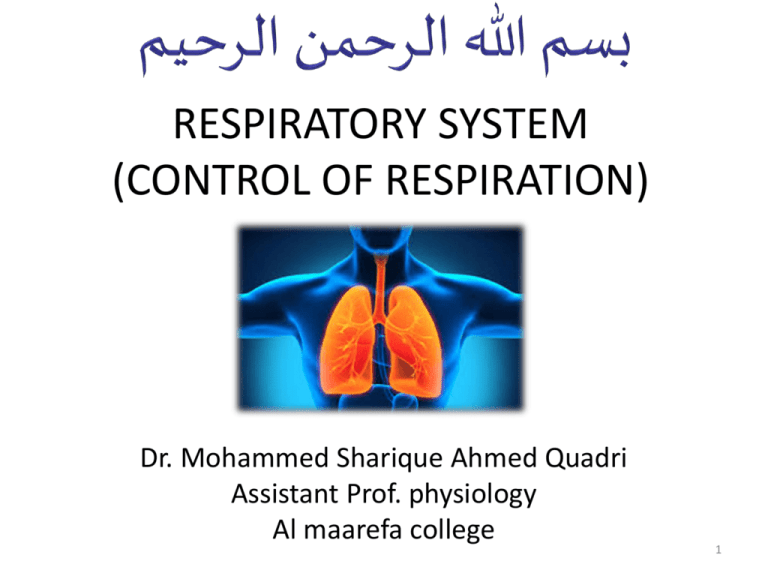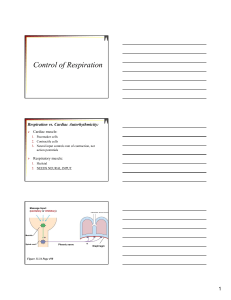control of respiration
advertisement

RESPIRATORY SYSTEM
(CONTROL OF RESPIRATION)
Dr. Mohammed Sharique Ahmed Quadri
Assistant Prof. physiology
Al maarefa college
1
Objectives
• To understand how the respiratory centers
control breathing to maintain homeostasis.
• To examine how PCO2, pH, PO2, and other
factors affect ventilation.
• To understand the relationship between
breathing and blood pH.
Control Of Respiration
• Respiratory process is involuntary process, but
under voluntary control as we can stop
breathing.
• Respiratory center is in the brain stem. It
causes rhythmic breathing pattern of
inspiration and expiration.
• Inspiratory and Expiratory muscles are skeletal
muscles and contract only when stimulated by
their nerve supply.
3
Neural Control Of Respiration
We will discuss
1. Center that generate inspiration and
expiration.
2. Factors that regulate rate and depth of
respiration .
4
Respiratory Center
In Medulla
- Inspiratory center
- Expiratory center
These are neuronal cells that provide output to
respiratory muscles for inspiration and expiration.
In Pons
- Pneumotaxic center – upper pons
- Apneustic center – lower pons
Pontine Center influence the output from
medullary centers.
5
6
Respiratory Center
• Inspiratory and Expiratory neurons in the
medullary center.
• We are breathing rhythmically in and out
during quiet breathing because of alternate
contraction and relaxation of inspiratory
muscles [diaphragm and External-intercostal
muscles] supplied by phrenic nerve [C-3,4,5]
and intercostal nerves .
7
Respiratory Center
• Order comes from medullary center to spinal
cord motor neuron cell bodies [anterior horn
cells].
• When these motor neurons are activated,
they stimulate the inspiratory muscles leading
to inspiration.
• When these neurons are not firing, the
inspiratory muscles relax and expiration takes
place.
8
Respiratory Center
Medullary respiratory center
• It has two neuronal groups:
1. Dorsal Respiratory Group [DRG] –
Inspiratory neuron.
2. Ventral Respiratory Group [VRG] –
Expiratory neuron.
9
Respiratory Center
Dorsal Respiratory Group [DRG]
• It consist of mostly inspiratory neurons, when
DRG fire(inspiratory ramp signals), inspiration
takes place, when they stop firing, expiration
takes place.
• Inspiratory “ramp” signals begins weakly and
increases steadily in a ramp manner for about 2
sec,(initiating inspiration) then it ceases abruptly
for 3 sec(leads to expiration).
• DRG has important connection with VRG.
10
Respiratory Center
Ventral Respiratory Group [VRG]
• It is composed of both inspiratory and expiratory
neurons.
• These neurons remain totally inactive during
normal quite breathing
• Appears to function mainly during forced
expiration, stimulating the internal intercostals
and abdominal muscles to contract
12
Respiratory Center
Generation of respiratory rhythm
• Before it was thought that DRG generates the
respiratory rhythm.
• Now it is believed that rhythm is generated by
Pre – Botzinger Complex. It displays pacemaker activity causing self induced action
potential.
• It is located near the respiratory center.
13
Pontine Respiratory Centers
• A pneumotaxic center, located
dorsally in upper Pons.
• The primary effect is to control the
“switch-off” point of the inspiratory
ramp signals from DRG of neurons
• The function of the pneumotaxic
center is primarily to limit inspiration
Pontine Respiratory Centers
• The apneustic area in the lower Pons sends
stimulatory impulses to the inspiratory area that
activate it and prolong inhalation.
• It causes deep inspiration when Pneumotaxic
center is damaged, Apneusis occurs [Deep
Inspiration]
• Thus pontine centers modify inspiration and
allow for smooth transitions between
inspiration and expiration.
15
Respiratory Center
‘Summary’
• Inspiratory center [DRG] – Inspiration
• Expiratory center [VRG] – used during forced
Expiration
• Pneumotaxic center – acts on inspiratory
center to stop inspiration therefore regulates
inspiration and expiration.
• Apneustic center – causes Apneusis [deep
inspiration] when Pneumotaxic center is
damaged.
16
Overall Control of Activity of Respiratory Centre
Chemical Control of Respiration
• Although the basic rhythm of breathing is established
by the respiratory centers, it is modified by input from
the central and peripheral chemoreceptors.
• They respond to changes in the PCO2, pH, and PO2 of
arterial blood, which are the most important factors
that alter ventilation.
• The ultimate goal is to maintain proper concentration
of O2 and CO2 in the body
CHEMORECEPTORS
• There are two types of Chemoreceptors
1. Peripheral Chemoreceptors
2. Central Chemoreceptors
19
1- Central Chemoreceptors Pathway
Central chemoreceptors
• Lying just beneath
ventral surface of
medulla
• Sensitive to H+ generated
from CO2 within the CSF .
• Sends signals directly to
the respiratory centers.
• Most sensitive to change
in PCO2 ,H+ conc., but
not to PO2
1- Central Chemoreceptors Pathway
Central chemoreceptors
• Under normal conditions, ~75-85% of
respiratory drive is due to stimulation of
central chemoreceptors by CO2
• Central chemoreceptors are directly stimulated
only by H+
• But H+ can not cross blood brain barrier while
CO2 can
• So, how central chemoreceptors are
stimulated by an increase in arterial PCO2?
Medullary
respiratory
center
Increase
ventilation
Decrease
arterial Pco2
4th ventricle
Central chemoreceptors are stimulated by an INCREASE in H+ & PCO2
Peripheral Chemoreceptors
•
•
•
•
Carotid bodies [cont]
Carotid body sends impulse to respiratory center
in medulla via IX cranial nerve [glassophyrangeal].
Aortic bodies
These receptors are situated in the aortic arch .
They also sense the O2, CO2, and H+ ion changes
in the blood.
Aortic body sends impulse to respiratory center
in medulla via X cranial nerve [vagus].
23
24
2- Peripheral Chemoreceptor Pathway
Stimulation of Peripheral chemoreceptors
• The carotid & aortic bodies are
sensitive to fall in PO2, an
increase in PCO2 or H+
concentration
• They maximally stimulated
when PO2 decreases below
60mm Hg
• They detect changes in
dissolved O2 but not in the O2
that is bound to Hb (e.g. in
anaemia there is normal PO2
but reduced content of O2
bound to Hb)
Summary of the Effect of ↑arterial PCO2
on ventilation
Effect of a decreased arterial PO2
Effects of increased arterial H+ that are not due to
altered co2on ventilation
Arterial non CO2-H+
acidosis
relieves
+
Peripheral
chemoreceptor
+
Medullary
respiratory
no
center
+
Increase
ventilation
decrease arterial
pco2
decrease co2-H+
cannot penetrate BBB
Central
chemoreceptor
Summary of Chemical Pathways stimulating Ventilation
II- Neurogenic Reflexes
•
•
•
•
Hering-Breuer Reflex
J- receptor reflex Reflex
Cough & sneezing Reflexes
Other influences (mediated via
hypothalamus)
Hering – Breuer Reflex
• When tidal volume is large, more than 1 liter e.g.
during exercise, then Hering Breuer Reflex is
triggered to prevent over inflation of the lungs.
How ?
• There are stretch receptors in the bronchioles,
they are stretched by large tidal volume.
• Action Potential from stretched receptor go via
afferent X cranial nerve ( vagus ) to medullary
center and inhibit inspiratory neuron.
• This negative feedback mechanism helps to cut
inspiration before lungs are over inflated.
31
Neurogenic Reflexes
2- J-receptor Reflex
• Pulmonary emboli or oedema
→juxtapulmonary-capillaries receptors →vagal
afferent to respiratory centre → rapid shallow
respiration
• These receptors are responsible for the sensation
of air hunger (Dyspnea; shortness of breath)
Neurogenic Reflexes
3- Cough, Sneezing reflexes
• Dust, smoking, irritant substances →
stimulation of irritant receptors in upper
airways →afferent signals via vagus (Upper
airways, {larynx, cough}) or trigeminal or
olfactory (nose, sneezing) → respiratory centre
→ deep inspiration followed by forced
expiration against closed glottis →opening of
glottis →forceful outflow of air
Neurogenic Reflexes
Other Influences from higher centres
hypothalamus & limbic system
• Temperature: Increases respiratory rate
• EMOTIONS : Increases respiratory rate
35
‘Summary’
• PERIPHERAL CHEMO RECEPTORS ARE Most
SENSITIVE TO decreased Po2 .
• central chemoreceptors are most sensitive to
Increased increased H+ ion in the brain ECF
.strongly stimulates the and dominant control of
ventilation.
-Decreased PO in the arterial blood – depresses
the central chemoreceptors.
2
36
References
• Human physiology by Lauralee Sherwood,
seventh edition
• Text book physiology by Guyton &Hall,11th
edition
• Text book of physiology by Linda .s
contanzo,third edition







